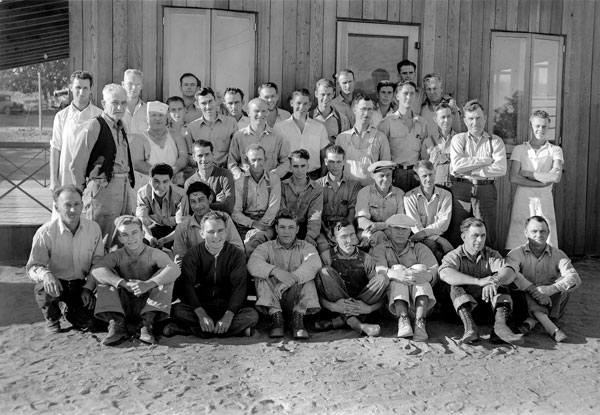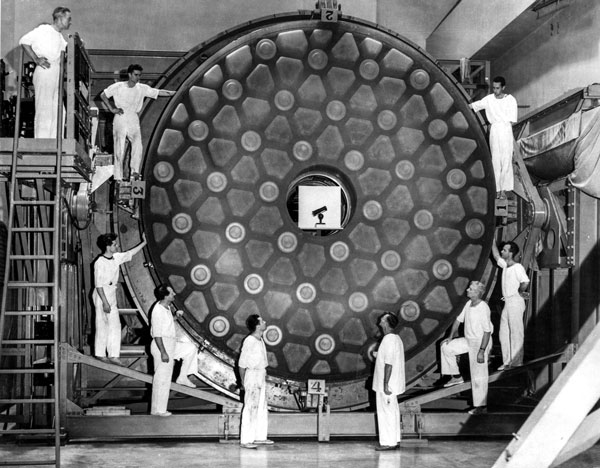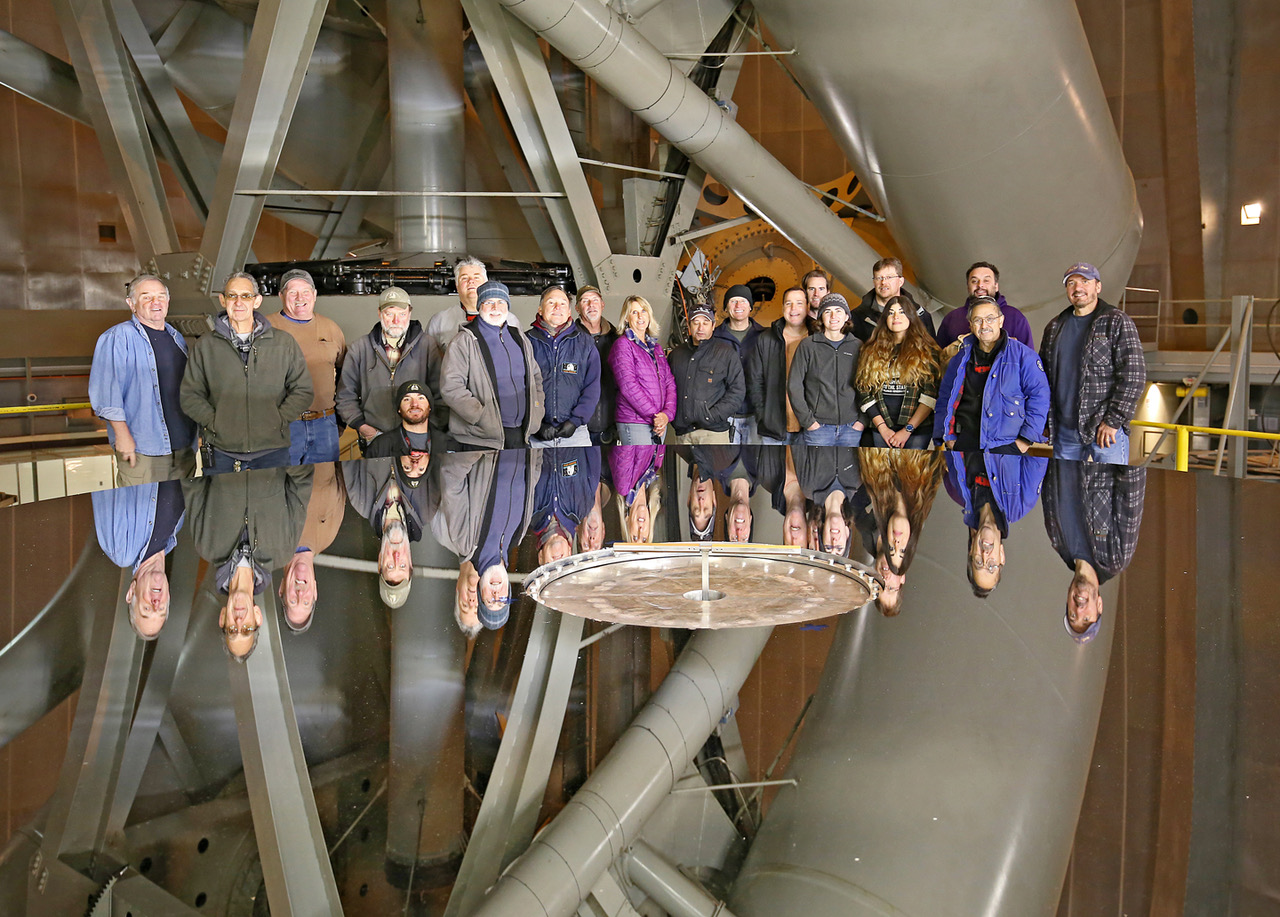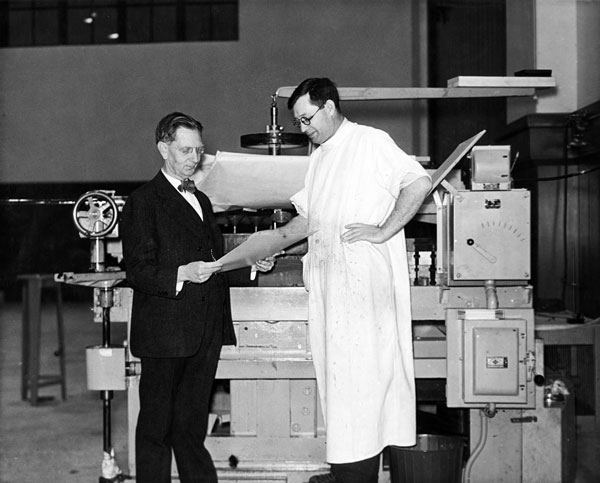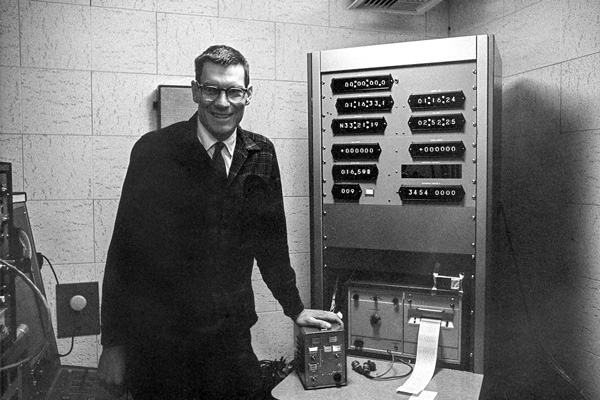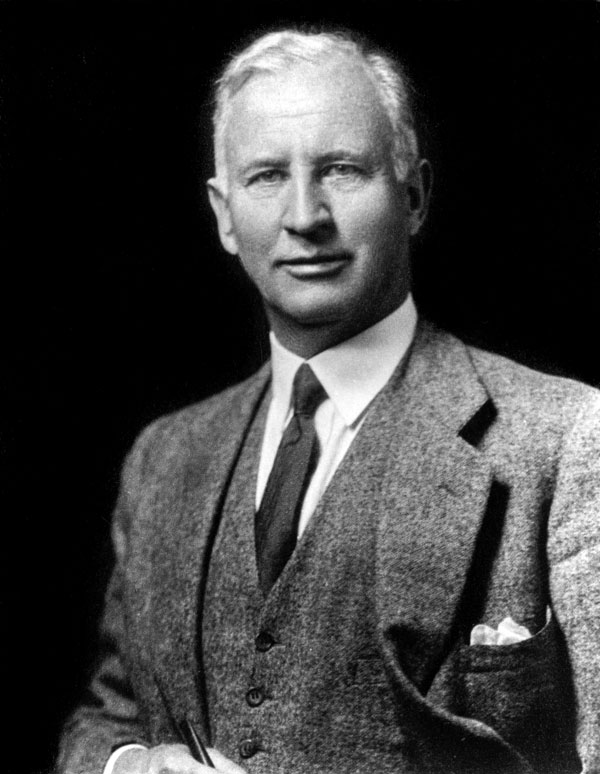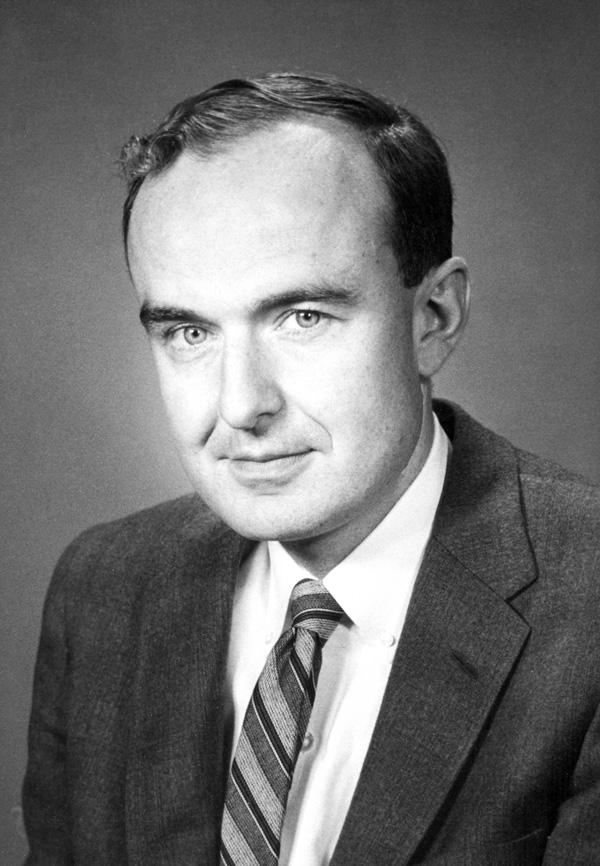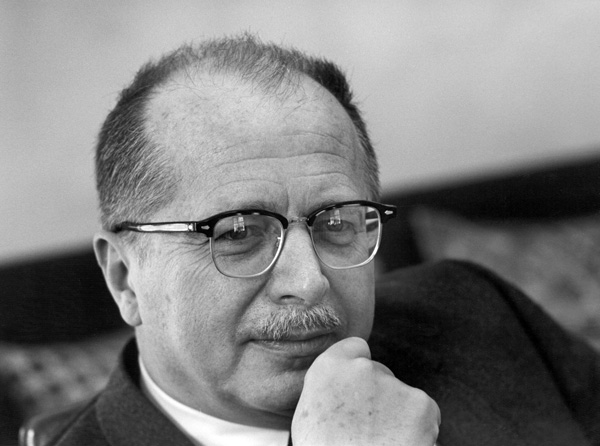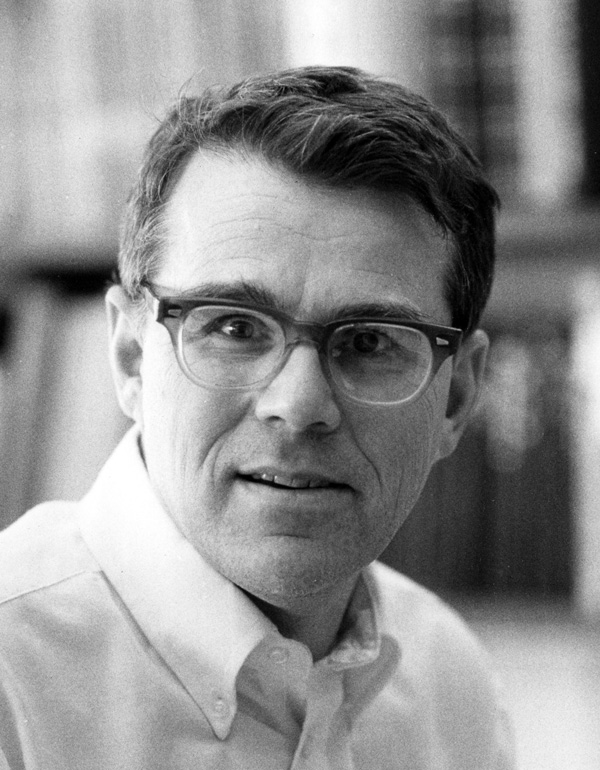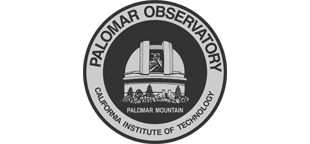
|
Celebrating 75 Years of Discovery
|

|
Palomar Observatory Notable Personalities
Early on Palomar Observatory made the transition from project to scientific icon, prominent worldwide for its many accomplishments and more broadly for what it represents—humankind's quest to understand the Universe and our connection to it. It is of course not the place or the instruments, but the people who have made Palomar iconic over and through its long history.
Literally thousands of people have contributed to Palomar's conception, construction, and scientific accomplishments. Here we try to recognize a representative cross-section of the visionaries, leaders, scientists, and engineers who have made important contributions to Palomar Observatory and its enduring legacy.
- Founders and patrons
- Designers, engineers, and instrumentalists
- George McCauley
- Rein Kroon
- Mark Serrurier
- Francis Pease
- Russell Porter
- Marcus Brown
- Don Hendrix
- John Strong
- Bruce Rule
- Edwin Dennison
- Bev Oke
- Leaders
- Groundbreaking scientists
- Fritz Zwicky
- Walter Baade
- Rudolph Minkowski
- Allan Sandage
- George Abell
- Jesse Greenstein
- Maarten Schmidt
- Vera Rubin
- Wal Sargent
- Eleanor Helin
- Gerry Neugebauer
- James Gunn
- Gene and Carolyn Shoemaker
- Mike Brown
- Alphabetical index
- References
Contents
Founders and Patrons
George Hale
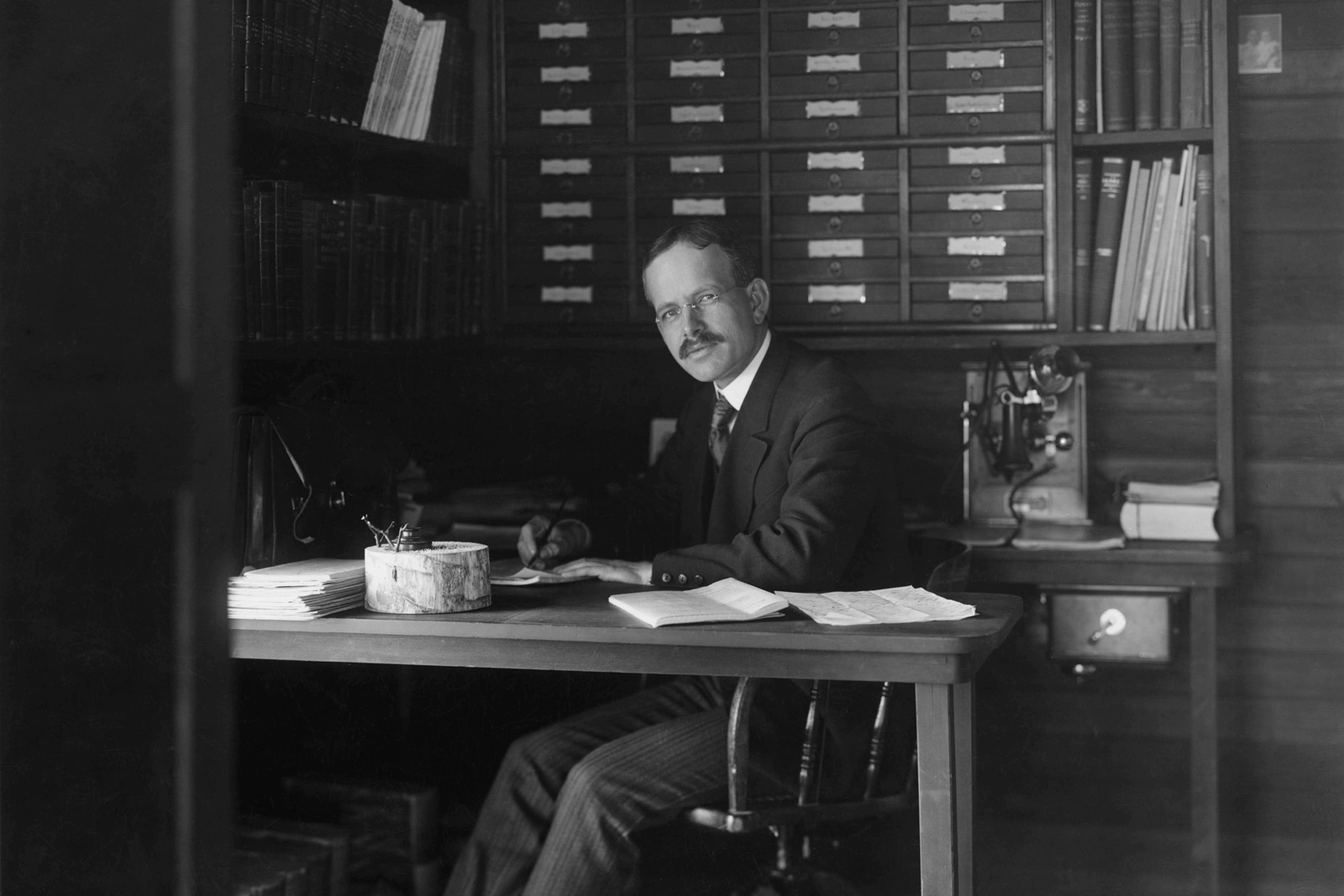
George E. Hale, seated at his office desk at the Monastery at Mt. Wilson Observatory, ca. 1905. (Huntington Library)
George E. Hale. Duration: 2:12 min. (Palomar/Caltech)
George Ellery Hale (1868 – 1938) was an American solar astronomer, builder, organizer and science entrepreneur. He is best remembered for having led the design, funding and construction of the Yerkes, Mount Wilson, and Palomar Observatories.
Hale graduated from MIT in 1890 with a Bachelor of Science degree and soon began building a scientific reputation with his invention of the spectroheliograph. In time, using improved versions of this instrument, Hale was first to detect magnetic fields on the Sun.
While teaching at the University of Chicago, he established and co-edited the Astrophysical Journal in 1895, the premier publication for research in astronomy and astrophysics. He was elected to the National Academy of Sciences in 1902 and he later helped organize the National Research Council in support of the nation's war efforts. In 1904, Hale was appointed director of the Mount Wilson Observatory and settled in Pasadena, California, where he became deeply involved in local education and culture, including the co-founding of Caltech and the creation of the Huntington Library. He served on Caltech's Board of Trustees from 1907 until his death in 1938.
Hale raised funds for the 200-inch Palomar telescope and served on the Observatory Council that oversaw its construction. When the telescope was dedicated in 1948, it was named the Hale Telescope in his honor. [a39] [d39]
Designers, Engineers, and Instrumentalists
George McCauley
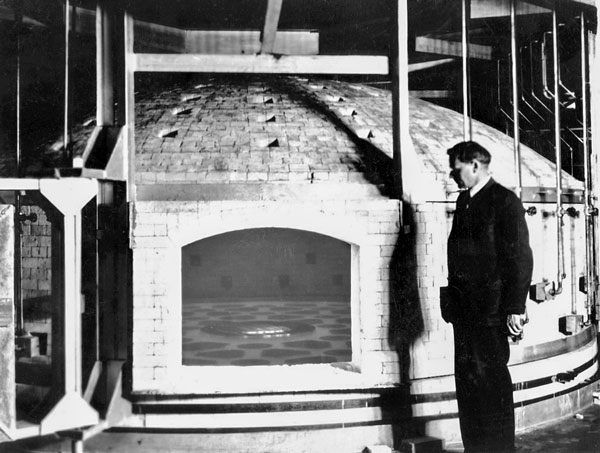
George McCauley beside the beehive oven after the pouring of the 200-inch Pyrex blank. Photo by Ayres A. Stevens, 2 December 1934. (Corning Glass Works)
George V. McCauley (1882 – 1976) was an American research physicist who, during a 29-year career at Corning Glass Works, supervised the production of mirror blanks for several of America's largest observatories. McCauley graduated from Northwestern University with a bachelors of science degree. In 1911, he received his Ph.D. in physics from the University of Wisconsin. He taught briefly at Northwestern and was employed by the U.S. Bureau of Standards during World War I.
McCauley began his career at Corning Glass Works in June 1918. Tasked with conducting research for special projects, he designed and managed the casting and annealing of the mirror blank for 200-inch telescope at Palomar Observatory. After an initial failure, a successful disk was obtained in December 1934 and, following an extended cooling and annealing period, was shipped to Caltech in March 1936.
McCauley supervised the casting of mirror blanks for, among others, the Lick, Dunlap, McDonald, and Harvard observatories. [pt76] [nyh] [cmog]
Rein Kroon
Rein Kroon and another Westinghouse engineer testing strain on celluloid model of mount for Hale Telescope. (Hagley)
Reinout P. Kroon (1907 – 1992) was a Dutch mechanical engineer who immigrated to the United States in 1931 after earning his M.S. degree from the Federal Technical Institute in Zurich, Switzerland. Joining Westinghouse Corporation that year, he soon became a development engineer in the Steam Division.
In late 1935, Westinghouse sent Kroon to Pasadena to work on the details of the mounting of the 200-inch telescope. During his six-month assignment, Kroon solved three major design issues. First, he designed the hydrostatic pressure system with which the telescope turns in right ascension on a thin film of oil. Second, he designed the horseshoe and ball bearings for the north and south ends of the yoke. Finally, he designed the spoked declination bearings that allow the telescope to travel north and south.
Later, Kroon became head of engineering research at Westinghouse where he managed a team that in 1945 developed the first commercially viable American jet engine. In 1960, he joined the engineering faculty at the University of Pennsylvania where he rose to the position of chairman of the graduate division of mechanical engineering. [k70]
Mark Serrurier
Mark U. Serrurier (1904 – 1988) was an American engineer and 1926 graduate of Caltech. When he went to work for Caltech in 1932, he joined the design team then working on plans for the 200-inch telescope. Serrurier's most notable contribution to the project was his invention in 1935 of a truss system for the telescope's tube, the "Serrurier Truss," now used in telescopes around the world.
The "Serrurier Truss" provides a tube framework for telescopes as a way of controlling flexure. Because loads and strains are carried evenly around the structure, sag is identical at the top and bottom of the tube thus insuring that the optical components remain collimated whatever the telescope's orientation.
After World War II, Serrurier became president of his father's company, Moviola, a maker of film editing equipment. In 1979, he accepted for himself and posthumously for his father an Academy Award for their technical contributions to the movie industry. [a88]
Francis Pease
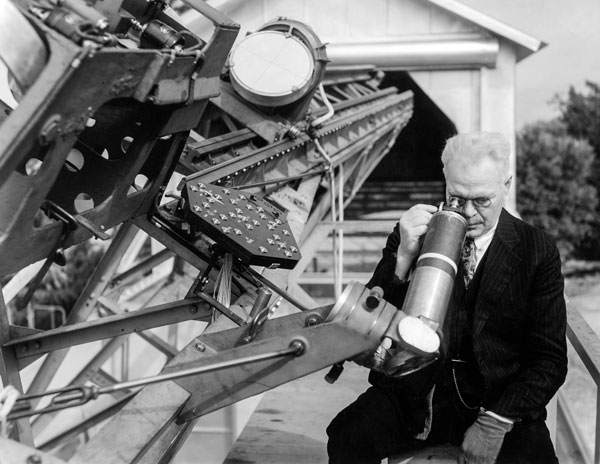
Francis Pease observing at Mt. Wilson with the 50-ft stellar interferometer, 1930. (Caltech Archives)
Francis G. Pease (1881 – 1938) was an American Astronomer specializing in telescope design and instrumentation. Pease joined the Mt. Wilson Observatory in 1903, and participated extensively in the development of the 100-inch Hooker Telescope at Mt. Wilson, and the design of the 200-inch Hale Telescope at Palomar. Pease is credited with many important insights into scaling the Hooker design experience to the larger Hale Telescope, particularly in planning for the Hale primary mirror structure.
Separately Pease worked closely with Albert Michelson in developing and using the 20-foot interferometer boom on the Hooker Telescope—with which he and Michelson published seminal measurements of apparent stellar diameters in 1921. Pease then went on to deploy and use a dedicated 50-foot stellar interferometer also at Mt. Wilson. These first-of-a-kind Michelson-Pease measurements provided important empirical constraints on our theoretical understanding of stellar atmospheres and radiative processes. Though primarily known for engineering contributions, Pease skill as an observer was under-appreciated; his careful observations with the interferometers was key to the success of the Michelson-Pease program. [mo39]
Russell Porter
Russell W. Porter. Duration: 1:17 min. (Palomar/Caltech)
Russell W. Porter (1871 – 1949) was an American engineer, Arctic explorer, engineer, amateur astronomer, and architect. He studied civil engineering at Norwich University and later graduated from MIT with a degree in architecture. His career is best remembered for his contributions in two areas: his work with Palomar Observatory and the Hale Telescope and his role as a cofounder of amateur telescope making in America.
In 1928, George Hale asked Porter to join the 200-inch telescope project as an associate in optics and instrumental design. In that capacity, he laid out the Observatory and designed its buildings. The split-ring yoke mounting of the telescope represents an innovation for which he often is given credit. During construction, Porter executed a series of "cutaway" drawings of the telescope that gave a three dimensional context to the engineering drawings.
In 1923, Porter organized the first meeting of the Springfield Telescope Makers. The group soon built a clubhouse named Stellafane, which became the site of an annual convention of telescope makers that continues to present. [p48] [seh]
Porter's unparalleled contributions to the development of Palomar and Caltech are explored in detail in our digital exhibit Russell W. Porter at Caltech.
Marcus Brown
Marcus H. Brown (1893 – 1961) was an American optician noted for his work grinding and figuring the Hale Telescope's 200-inch primary mirror. With no training as an optician, in 1928 he joined the staff of the optical shop at Mt. Wilson Observatory as an apprentice. The experience he gained, combined with study on his own, led to his appointment in 1931 by John Anderson as optician in charge of grinding the 200-inch mirror.
Between 1932 and 1936, Brown organized the Caltech optical shop, selected his crew, and developed tools and procedures. After the arrival of the mirror blank in April 1936, he supervised the work of the 21-man crew who ground off more than 5 tons of Pyrex and brought the mirror's surface to its nearly perfect parabolic figure.
Delayed by the war, in November 1947, Brown signed his name on the inner edge of the glass and then packed the finished mirror for shipment to the Observatory. He was the only person who had stayed with the 200-inch disk for the 11 years of the work. [es48]
Don Hendrix
Donald O. Hendrix (1905 – 1961) was an American optician and inventor. With only a high school education and no experience with optics, in 1931 he was hired at the optical shop at Mt. Wilson Observatory as an apprentice optician. However, he soon acquired skills and a reputation for excellence. A master optician by 1942, that year he was appointed head of the optical shop.
In 1940, Hendrix completed the 72-inch primary mirror for the Palomar Schmidt telescope. But further work stopped as the optical shop shifted to defense work. Following the war, the Schmidt project resumed and Hendrix finished the corrector plate in 1948. When the telescope's science programs began on September 29, 1948, he took the first official image.
With the arrival of the 200-inch mirror at Palomar in November 1947, Ira Bowen appointed Hendrix the Hale Telescope's new chief optician. Hendrix finished figuring the primary mirror, ground and polished the secondaries, and successfully applied aluminum coatings to them all. In November 1949, Bowen pronounced the mirror satisfactory and science programs began on the Hale Telescope.
Thereafter, Hendrix participated in many mirror projects. Most notably, he ground and figured the 120-inch primary for the Shane Telescope, which began operations at Lick Observatory in 1959. [o03]
John Strong
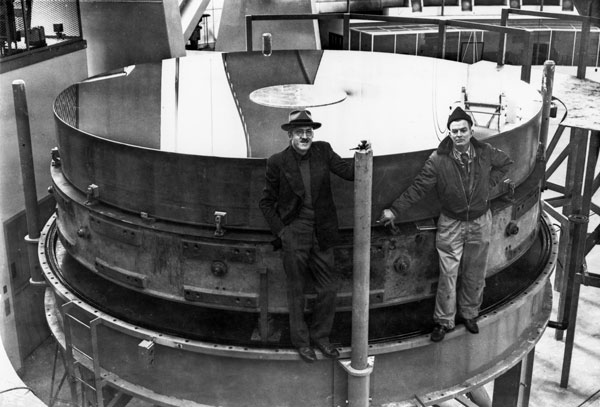
John Strong (left) and Donald O. Hendrix with the 200-inch mirror after its first aluminum coating, 25 November 1947. (Caltech Archives)
John D. Strong (1905 – 1992) was an American scientist and inventor known for his innovations in optical devices especially anti-reflective coatings and diffraction gratings. He graduated from the University of Kansas in 1926 and received his doctorate in physics from the University of Michigan in 1930.
That year, Strong joined Caltech and in 1932 succeeded in depositing a thin coating of aluminum in a high vacuum on a glass telescope mirror. Four years later, aluminum's superiority over silver was demonstrated when he aluminized the mirror of the 100-inch Hooker Telescope. Aluminum resists tarnishing and does not contain the light scattering scratches left by burnishing.
In 1947, Strong to returned to Caltech from Johns Hopkins to supervise the coating of the Hale Telescope's 200-inch mirror. There he solved the two key problems of gaining a sufficiently high vacuum and of obtaining a sufficiently clean glass surface.
Working in the 1950s, Strong was the first researcher to detect water in the atmosphere of Venus. [l92]
Bruce Rule
Bruce H. Rule (1908 – 1990) was an American engineer and instrument designer. During his 40-year career, he was associated with the design and construction of 18 of the world's major optical and radio observatories.
Rule graduated with a BS in engineering from Caltech in 1932 and came back to Caltech in 1937 to join the Palomar telescope project, becoming chief engineer in 1938. Concentrating on the electrical systems, with Byron Hill, he oversaw the telescope's assembly on Palomar Mountain.
Rule was engaged in rocket and torpedo research during World War II. Returning to the 200-inch telescope, he took over supervision of the mechanical, electrical and drive systems where he is credited with solving major issues with the mirror supports and the horseshoe mounting.
Later, Rule became involved with the design and construction of the Owens Valley radio interferometer. In 1966, he was appointed chief engineer of the Hale Observatories and project officer for the 100-inch Du Pont Telescope in Las Campanas, Chile. He retired from Caltech in 1976. [b77] [r48]
Edwin Dennison
Edwin W. Dennison (1928 – 2012) was an astronomer and self-taught gadgeteer who led the Hale Observatories Astro-Electronics Lab and pioneered use of electronics and digital computers to collect astronomical data at Palomar.
The son of a University of Michigan physicist, Dennison did his undergraduate studies at Swarthmore College in Pennsylvania and subsequently studied with Dutch astronomer Peter Van De Kamp in the Netherlands. Back in Michigan, he earned his Ph.D. from UM under the tutelage of solar astronomer Leo Goldberg. Dennison went on to a career in solar physics at Sacramento Peak Solar Observatory in New Mexico for several years.
In 1963, Dennison was recruited by Horace Babcock (then director of Mt. Wilson and Palomar Observatories) and came to Caltech as a researcher, where he began to develop electronic systems for telescopes. In 1966 he was made the director of the new Astro-Electronics Laboratory, devoted to the modernization of existing instruments and the development of new devices and techniques. In just three years, his lab grew to employ about a dozen people. Dennison’s devices were well received at Palomar, and by 1970 about a third of astronomers at the Hale Telescope were using a digital data-recording system. The overall development of the electronic system to operate Palomar’s new 60-inch telescope (one of the first telescopes to be designed specifically for use with a computer) was also due largely to Dennison and his lab.
In 1974 Dennison moved to the Jet Propulsion Laboratory, where he continued the development of electronic instruments for spacecraft until his retirement in 2000. [mc06] [d67] [d70]
Bev Oke
John Beverley Oke (1928 – 2004) was a Caltech astronomer who specialized in spectroscopy (the study of starlight dispersed according to its wavelength/color) and is well known for the development of advanced instrumentation for Palomar and Keck observatories. Oke earned his doctorate from Princeton University in 1953, and was a member of the Caltech faculty from 1958 until his retirement in 1992. He was also a staff member of the Hale Observatories (Mount Wilson and Palomar) and served as associate director from 1970 to 1978.
The first instrument Oke built after joining the Caltech faculty was a single-channel scanner for the Hale Telescope that could measure the spectra of stars and galaxies in successive 10-nanometer-wide segments. In 1963, this spectrophotometer played a key role in the discovery of quasar 3C 273's redshift. In 1968, he completed an innovative 32-channel photoelectric spectrometer. Using this instrument with students and colleagues, Oke pursued a highly successful quest to establish accurate spectral-energy distributions (energy as a function of wavelength/color) for diverse classes of stars and galaxies, based upon rigorous calibration against physical standards.
In the late 1970s, Oke and Jim Gunn designed and built a double spectrograph that split the light beam to go through two separate spectrographs, one fitted with a CCD optimized for blue light, the other with a CCD optimized for red. This instrument, now with upgraded CCD technology, is still in use at the Hale Telescope.
Just after Oke’s retirement from Caltech in 1992, Keck Observatory commissioned a low-resolution imaging spectrograph that he designed and built with astronomy professor Judith Cohen. It produced many of Keck’s early successes, including the discovery and analysis of hundreds of galaxies at very high redshifts. [m04] [g05] [e04]
Leaders
John Anderson
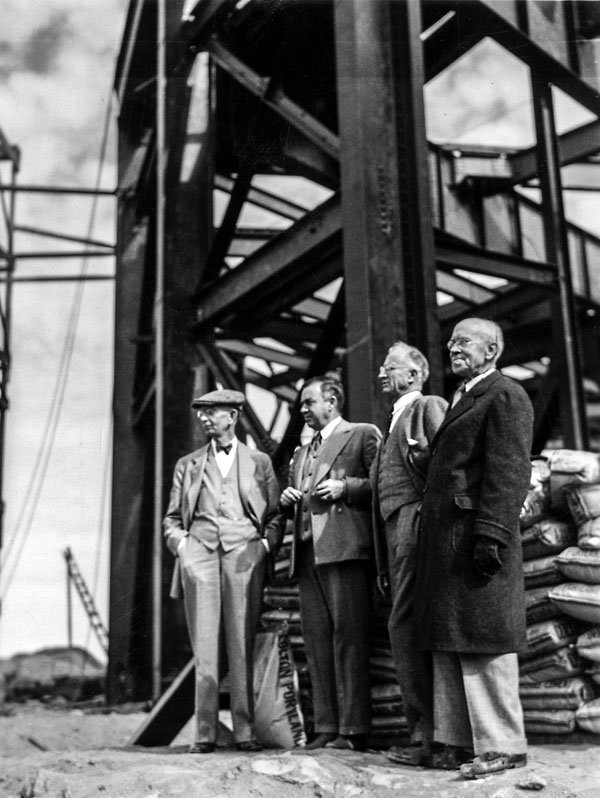
John Anderson, Clyde McDowell, Max Mason, and Russell Porter at Palomar, 11 November 1936. (Caltech Archives)
John A. Anderson (1876 – 1959) was an American astronomer and administrator noted for creating precision diffraction gratings, for pioneering the science of stellar interferometry, and for supervising the design of the 200-inch telescope. After receiving his Ph.D. in 1907 from Johns Hopkins University, he remained at Hopkins where he served first as instructor and later as associate professor of astronomy.
In 1916, at George Ellery Hale's request, Anderson joined the staff at Mt. Wilson Observatory. There he worked with Harry O. Wood to create the torsion seismograph. In 1919, Anderson modified the Michelson interferometer and, with Francis Pease, used the instrument to resolve the components of the star Capella, the first interferometric measurement of any object outside the Solar System.
In 1928, Hale asked Anderson to serve as executive officer of the Observatory Council, whose charge was to oversee the 200-inch telescope project. Over twenty years, Anderson directed and participated in the site selection, the establishment of an optical shop, and the design and testing of the telescope's structure, instrumentation and mirror. Anderson continued in this role until the telescope's dedication in June 1948. [b62] [hea14]
Ira Bowen
Ira S. Bowen (1898 – 1973) was an American physicist and astronomer recognized for his fundamental contributions to the analysis of atomic spectra, the physics of gaseous nebulae and applied optics. He graduated from Oberlin College in 1919. Later at the University of Chicago, he studied physics under Robert Millikan whom he soon accompanied to Caltech.
There Bowen served as Millikan’s assistant, taught physics, researched cosmic rays, and earned his Ph.D. His best-remembered achievement stemmed from his investigation of ultraviolet spectra of gaseous nebulae. While certain spectral lines were believed to represent the undiscovered element “nebulium,” Bowen demonstrated that these features were in fact the forbidden lines of ionized oxygen and nitrogen. In time, he identified most of the spectral lines seen in these nebulae.
In 1946, Bowen was appointed director of Mt. Wilson Observatory. From 1948 to 1964, he served as director of the combined Mt. Wilson and Palomar Observatories during which time he directed the completion of the 200-inch Hale Telescope and the 48-inch Schmidt telescope while also designing many of these telescopes' instruments. [w68] [w69] [b82]
Max Mason
Charles Max Mason (1877 – 1961) was an American mathematician and physicist whose principal research areas were in differential equations, calculus of variations, and classical electromagnetic theory. Mason received degrees from University of Wisconsin-Madison and the University of Göttingen, studying with David Hilbert. During his academic career Mason served on the faculties of MIT, Yale, Wisconsin-Madison, and Chicago.
Mason transitioned to Director of Natural Sciences (and soon thereafter President) of the Rockefeller Foundation in June 1928—in time to administer the Palomar funding grant to construct the 200-inch telescope. Mason actively engaged with the Palomar development team over the next decade, and then transitioned to Caltech in 1938 to Chair the Observatory Council as Hale’s health was failing. Under Mason’s leadership the 200-inch telescope was completed and dedicated as the Hale Telescope in June 1948. In addition to administration, Mason contributed to solving telescope engineering problems, particularly the Hale primary mirror support system. Mason also served Caltech as a member of the Executive Council and Board of Trustees. [w64] [ocr05]
Clyde McDowell
Clyde S. McDowell (1884 – 1957) was a naval officer and a 1904 graduate of the U.S. Naval Academy at Annapolis. While completing his Ph.D. at the University of Wisconsin, he met Max Mason. During World War I, McDowell commanded the Naval Experiment Station where he hired Mason to do research on acoustic devices for anti-submarine warfare. At this time, McDowell also did work for the Naval Research Council where he met George Ellery Hale.
In late 1934, having gotten leave from the Navy, McDowell at Mason's request accepted a temporary, non-salaried position as overall coordinator and planner of construction. In that capacity, he supervised the design of the mounting and control systems, let fabrication contracts to Westinghouse and others, and imposed a disciplined management structure on the work at Palomar and in Pasadena.
McDowell contributed important project leadership during a key period in telescope development, but his management style did not mesh well with the project environment. In 1938 McDowell left the project to pursue other opportunities.
Byron Hill
Byron A. Hill graduated from Caltech in 1925 with a B.S. in civil engineering. He turned to work in concrete construction and, among work in a variety of engineering capacities, he served from 1933 to 1936 as superintendent of inspections for he Metropolitan Water District, which was then building the aqueduct to carry water from the Colorado River to Los Angeles.
In 1936, Clyde McDowell hired Hill as resident construction supervisor for the building of Palomar Observatory. He oversaw the raising of the dome and, when massive machined sections began to arrive early in 1938, he and his crew began assembling the telescope.
After World War II, Hill planned the mirror's move from Pasadena. He supervised the crew of workers who completed the mirror's coating and installation. In the final stages of figuring, his team repeatedly mounted and removed the mirror as the opticians brought it to its required shape through an iterative process of polishing and testing.
In 1950, Hill became the first superintendent of Palomar Observatory, a position he held until his retirement from Caltech in 1966. [es48']
Ground-breaking Scientists

Astrophysics faculty. Front row: Jesse Greenstein, Fritz Zwicky, Guido Munch; back row: J. Bev. Oke, Maarten Schmidt. (Caltech Archives)
Fritz Zwicky
Fritz Zwicky (1898 – 1974), Caltech’s first astrophysics faculty, is known for his visionary and often provocative insights in astronomy. He was the first to propose the existence of dark matter, discovered over 120 supernovae, and produced the first great catalog of galaxy clusters.
Zwicky received a doctorate in physics in 1922 from the Swiss Federal Institute of Technology in Zürich, Switzerland. Three years later, having been awarded an international fellowship from the Rockefeller Foundation, Zwicky joined the Caltech faculty. Soon he established a productive collaboration with Walter Baade. In 1931–34 they coined the term “supernova” and proposed that these stars marked the transition from ordinary stars to neutron stars and were the origin of cosmic rays. After studying the Coma cluster of galaxies, Zwicky concluded that an invisible (“dark”), dominant form of matter must exist in order to explain the dynamics observed.
Zwicky and Baade saw the potential of the newly-invented Schmidt telescope as an instrument for broad reconnaissance. Within a year of the 18-inch becoming operational, Zwicky began his unprecedented success at recording supernovae. By 1973, he had discovered over 120 with the Palomar Schmidts and until 2009 held the record for the greatest number of supernova discoveries by any individual. Zwicky’s second major observational program at Palomar was the study of galaxy clustering. This study culminated with the publication of the six-volume Catalogue of Galaxies and of Clusters of Galaxies between 1961 and 1968. [gw74] [s13']
Walter Baade
W. H. Walter Baade (1893 – 1960) was a German observational astronomer known for his definition of two stellar populations, the discovery of two distinct kinds of Cepheid variable stars, and the doubling of the assumed scale of the Universe. Baade was educated at Göttingen University, where he received his Ph.D. in 1919. That year he joined the Hamburg Observatory staff and soon was the sole observer with its 1-m reflector, then the largest telescope in Germany.
During the 1925 solar eclipse Baade visited the U.S. where he met Harlow Shapley, director of the Harvard College Observatory, who helped him obtain a Rockefeller scholarship for an American stay from 1926 to 1927. During this stay Baade worked at the Harvard College, Yerkes, Lick, and Mt. Wilson observatories.
On his return to Hamburg, Baade was appointed principal observer, traditionally the position held by the successor to the current director. However, he forewent the future directorship in favor of a permanent post at Mt. Wilson in 1931. There, Baade and Fritz Zwicky identified supernovae as a new category of astronomical objects and proposed the existence of neutron stars. During World War II, Baade took advantage of wartime blackout conditions to resolve stars in the center of the Andromeda Galaxy. These observations led him to define distinct populations of stars and, as a result, of Cepheids. He continued his research at Palomar once the 200-inch Hale Telescope was ready in 1949. Using the new telescope, Baade recalculated the size of the known Universe doubling the previous calculation by Edwin Hubble in 1929. He and Rudolph Minkowski identified the optical counterparts of various radio sources, including Cygnus A, in the 1950s. [o01] [a61]
Rudolph Minkowski
Rudolph L. B. Minkowski (1895 – 1976) was a German-born physicist recognized for his work in the classification of supernovae and the interpretation of cosmic radio sources. In 1921, he received his Ph.D. in physics from the University of Breslau. After leaving a professorship in Hamburg, he joined the staff of the Mt. Wilson Observatory in 1935.
Using the 100-inch telescope, Minkowski and Walter Baade made spectrographic observations that in 1941 distinguished Type I and Type II supernovae. During the next two decades, Minkowski produced a series of papers on galactic dispersion velocities and the characteristics of planetary nebulae.
But Minkowski's greatest contribution was his supervision and successful completion of the National Geographic Society-Palomar Observatory Sky Survey. In charge of the entire operation, he adjusted the 48-inch Schmidt telescope, established observing procedures, supervised the three observers, and examined and qualified the plates. Through his high standards, the Sky Survey became a research tool used by astronomers around the world.
After he retired in 1960, Minkowski worked as a research astronomer with UC Berkeley’s Radio Astronomy Laboratory. [k76] [o83]
Allan Sandage
Allan R. Sandage (1926 – 2010) was an American astronomer who dedicated most of his professional career to measuring the Hubble constant (H0)—the rate at which the Universe is expanding. He also pioneered the fields of stellar evolution and galaxy formation, and discovered the first quasar. Under the tutelage of Walter Baade, Sandage received his Ph.D. from Caltech in 1953 while at the same time working as an assistant to Edwin Hubble at Mt. Wilson Observatory. His studies of globular cluster evolution allowed age estimation for these stellar groups for the first time.
After Hubble’s passing, Sandage continued the project of quantifying the expansion of the Universe. At the American Astronomical Society meeting of 1958, he presented his results obtained with the Hale Telescope—his estimate of H0 = 75 (km/s)/Mpc, compared to Hubble’s original estimate of 558 (km/s)/Mpc, is remarkably close to today’s value. In later years and with long-time collaborator Gustav Tammann, Sandage measured the distance to many galaxies using many different methods, and revised his value of H0 to 50 (km/s)/Mpc. This conflicted with the value of 100 (km/s)/Mpc determined by Gérard de Vaucouleurs and his collaborators. The debate over which of the two values was correct lasted decades and was not resolved until the late 1990s, when data from the Hubble Space Telescope found a value of 72 (km/s)/Mpc.
In 1961, Sandage published the comprehensive Hubble Atlas of Galaxies. In collaboration with Olin Eggen and Donald Lynden-Bell, he published a seminal paper modeling Milky Way formation through dynamical gas collapse. Sandage also discovered the starburst activity and black hole jets in the galaxy M82. [o10] [dv11]
George Abell
George O. Abell (1927 – 1983) was an American observational cosmologist, teacher and author. He earned his Ph.D. from Caltech in 1957. His greatest scientific contributions were his work on galaxy clusters and his discovery of the second-order clustering of galaxies in superclusters.
In 1953, Abell joined the National Geographic Society-Palomar Observatory Sky Survey (POSS I) as principal observer. In examining the plates, he was impressed by the extent to which galaxies were grouped into clusters. While earlier researchers had commented on this, now having the wide coverage of POSS I, he developed a statistically rigorous method to identify galaxy clusters. In 1958, Abell published a listing, the "Northern Section," of 2,712 clusters. This work was followed in 1989 by the "Southern Section," a catalogue of 1,361 southern sky clusters. Taken together, the Catalogue of Clusters of Galaxies for the first time revealed the large-scale structure of the Universe.
Abell joined the UCLA faculty in 1957. Committed to science education, he wrote Exploration of the Universe, a textbook widely used in undergraduate astronomy courses. [a89] [w77]
Jesse Greenstein
Jesse L. Greenstein (1909 – 2002) founded the Caltech astronomy department. He pioneered varied research fields in astrophysics—white dwarfs, magnetic fields, radio sources, quasars—by studying the physical and chemical processes behind the observations. Influenced by Donald H. Menzel and Cecilia Payne-Gaposchkin, Greenstein earned a Ph.D. from Harvard in 1937 having started there as an undergrad at age 16. He became a postdoc at Yerkes Observatory under Otto Struve. With Louis Henyey, Greenstein wrote several innovative articles on radiative transfer and designed a wide-angle camera for World War II reconnaissance aircraft. After the war, he began using high-resolution spectroscopy to derive the elemental abundances in stars.
Greenstein brought astrophysics to Caltech by appointing top-notch theorists who could be lured into becoming observers with the new Hale Telescope. It proved a successful strategy. Throughout his long (1948 – 1972) tenure as departmental executive officer, Greenstein became a mentor to subsequent generations of astronomers.
In 1951, with Leverett Davis, Greenstein proposed the magnetic alignment mechanism to explain interstellar dust polarization—one of the longest-lived theoretical results in the field. Using Palomar instruments, he assembled a large collection of high-resolution spectra of a wide variety of stars to be analyzed for chemical composition. Together with Maarten Schmidt, in 1964 he published a milestone paper on the redshifts of the recently discovered quasars. His white dwarf spectroscopy program resulted in another pioneering paper written with Olin Eggen, published in 1965. Greenstein continued studying white dwarf spectra in later years. [ph82] [g03] [w03]
Maarten Schmidt
Maarten Schmidt (1929 – 2022) was a Dutch astronomer known for providing indisputable evidence of an evolving Universe—quasars, found only at great cosmic distances, are associated with galaxies in a younger Universe.
Mentored by Jan Oort, Schmidt earned his Ph.D. from Leiden Observatory in 1956. During the 1950s, Schmidt and his collaborators mapped the spiral structure of the Milky Way and studied its mass distribution and dynamics, including the exchange of gas between stars and the surrounding medium. At Caltech, he worked on theories about the mass distribution and dynamics of galaxies. From this early period came his formulation of what has become known as the Schmidt law, which relates the density of interstellar gas to the rate of star formation occurring in that gas. He later began a study of the visible spectra of radio sources. In 1963 using the Hale Telescope, Schmidt identified the visible object corresponding to one of these radio sources, known as 3C 273, and also studied its spectrum. While its star-like appearance suggested it was relatively nearby, the spectrum of 3C 273 proved to have what was at the time a high redshift of 0.158, showing that it lay far beyond the Milky Way and thus possessed an extraordinarily high luminosity. Schmidt termed 3C 273 a “quasi-stellar” object or quasar—thousands have since been identified.
In the mid-1980s and 1990s, Schmidt researched X- and γ-ray sources with the space observatories ROSAT and CGRO. He held several prestigious administrative positions at scientific organizations and at Caltech, including director of the Hale Observatories between 1978 and 1980. [s08] [s13] [l89]
Vera Rubin

Vera Rubin with senior research fellow Konrad Rudnicki on her observing run at Palomar, December 1965. (Carnegie Institution)
Vera Rubin (1928 – 2016) was an American observational astronomer most acclaimed for her work on the motions of stars in galaxies and the clustering of galaxies in the Universe. Her research provided strong evidence for the existence of dark matter. With degrees from Vassar and Cornell, Rubin conducted research on the spatial distribution of galaxies for her Ph.D. from Georgetown in 1954. In 1965, she joined the Carnegie Institution after teaching for several years at Georgetown.
In the 1970s, Rubin set out to map the distribution of mass in spiral galaxies by measuring their rates of rotation. She found many galaxies to be rotating sufficiently quickly that they would fly apart unless some invisible “missing mass” were holding the structures together. Vindicating Fritz Zwicky’s earlier ideas, her work brought the concept of dark matter into the scientific mainstream.
In 1951, Rubin had been refused admission to graduate astrophysics program at Princeton because the department did not admit women. Nonetheless, 14 years later she observed on the Hale Telescope in her own name, the first woman ever to do so. Throughout her career, Rubin championed the role of women in science. [l89'] [st00] [o16]
Wal Sargent
Wallace “Wal” L. W. Sargent (1935 – 2012) was a British-born American observational astronomer who stood at the forefront of spectroscopy throughout his 50-year career. He earned his bachelor's, master's, and Ph.D. degrees from the University of Manchester and, after graduation in 1959, came to Caltech as a research fellow. Following two years at the Royal Greenwich Observatory, he returned to Caltech in 1966, becoming full professor in 1971 and Bowen Professor in 1981. He served as the director of Palomar Observatory from 1997 to 2000.
Sargent made many contributions to astrophysics. He demonstrated that most of the helium in the Universe was produced in the Big Bang. He provided the first dynamical evidence for the presence of supermassive black holes at the centers of galaxies and measured the mass of the Milky Way Galaxy using the radial velocities of its outer satellites.
Wal Sargent achieved distinction as both the pioneer and the leader in the astrophysics of the diffuse intergalactic medium and the chemical history of the Universe. [b12] [mc03] [sm15]
Eleanor Helin
Eleanor F. Helin (1932 – 2009) was a planetary scientist at Caltech and the Jet Propulsion Laboratory. She was a pioneer in the search and survey of near-Earth asteroids (NEAs).
Helin joined Caltech in 1960 as a geologist interested in meteorites and the impact origin of lunar craters. She began her hunt for asteroids in 1972 at Palomar Observatory using the 18-inch Schmidt telescope. Over time, her interest shifted to studying potential impactors in Earth's vicinity. Her work with the Palomar Planet-Crossing Asteroid Survey (PCAS) photographic program yielded its first near-Earth asteroid in 1973. As the technology became available, Helin and her team worked on automating the search for NEAs. This was accomplished with the Near-Earth Asteroid Tracking (NEAT) project, which began operations in 1996 at Haleakalā Observatory in Maui, Hawaiʻi, and at Palomar in 2001 with the Samuel Oschin Telescope.
Helin was awarded many honors, including NASA's Exceptional Service Medal and the naming of the minor planet (3267) Glo. The USS Helin (NCC-1692), a starship in the Star Trek franchise, was named after her for “having discovered an unprecedented number of asteroids and comets.” Indeed, the Minor Planet Center lists Helin among the top discoverers with over 500 asteroids and a dozen comets discovered or co-discovered. [mpc] [w98] [m09]
Gerry Neugebauer
Gerry Neugebauer (1932 – 2014) was an American astronomer known as one of the founders of ground- and space-based infrared astronomy. He was director of Palomar Observatory between 1980 and 1994 and led the science team for the first orbiting infrared observatory, the Infrared Astronomical Satellite (IRAS). Neugebauer received his Ph.D. from Caltech in 1960 and for two years during his U.S. Army service worked at the Jet Propulsion Laboratory on the Mariner 2 space probe infrared instrument. Back at Caltech in 1962, he joined the faculty as an assistant professor of physics.
With colleague Eric Becklin, in 1966 Neugebauer used an infrared detector on the Hale Telescope to obtain the first observations of the Milky Way’s center, which is obscured by dust when observed in visible light. They discovered the Becklin–Neugebauer Object, an intense source of infrared radiation in the Orion Nebula that is one of the brightest objects in the sky at wavelengths less than 10 micrometers.
Neugebauer and astrophysicist Bob Leighton conducted the world's first infrared sky survey, the Two-Micron Sky Survey (TMSS). The survey, published in 1969, revealed over 5000 relatively cool objects, including new stars still surrounded by their dusty pre-stellar shells and supergiant stars in the last stages of their evolution. His IRAS team later cataloged more than a half-million infrared sources, including galaxies as well as debris and dust around stars—an early indication of the existence of exoplanets. Neugebauer also played a major role in the design and construction of the W. M. Keck Observatory in Hawai‘i. [m14] [s14]
James Gunn
James E. Gunn (1938 – ) is regarded as one of the world’s premier designers of detection instruments. His two best-known projects—the camera for the Sloan Digital Sky Survey (SDSS) and the Wide Field and Planetary Camera (WFPC) designed with Jim Westphal for the Hubble Space Telescope (HST)—have been of fundamental value for the astronomical community. He is also known for being one of the few scholars with significant contributions in all three major areas of astronomy: theory, observation, and instrumentation.
Gunn earned a Ph.D. from Caltech in 1965 with a thesis on cosmology and the distribution of galaxies. While a graduate student, Gunn and Bruce Peterson predicted the Gunn–Peterson trough, a feature in the spectra of distant objects where UV light is absorbed by neutral hydrogen in the intergalactic medium. It was finally observed in 2001 in high-redshift quasars using data from SDSS.
In 1968, Gunn joined Princeton as an assistant professor and worked on pulsars with Jeremiah Ostriker. Then he accepted an appointment at Caltech in 1970. During that decade, he became deputy principal investigator on WFPC and built two instruments for the Hale telescope: a photoelectric spectrum scanner called the Prime Focus Universal Extragalactic Instrument (PFUEI) and the Four-Shooter camera—one of the first astronomical cameras to use CCDs and to do drift scanning. Gunn returned to Princeton in 1979 and, starting in 1987, began working on the SDSS camera with the goal of scanning the visible sky in about five years and building an enormous data archive which could be used for, among many other scientific projects, determining the 3-D structure of the Universe. [p87] [gy05] [mp09]
Gene and Carolyn Shoemaker
Eugene M. Shoemaker (1928 – 1997) was an American geologist known as one of the fathers of planetary science. In 1960 he confirmed the impact origin of Barringer (Meteor) Crater in Arizona.
Shortly after obtaining his Ph.D. from Princeton in 1960, Shoemaker founded the Astrogeology Research Program of the United States Geological Survey (USGS) in Flagstaff, Arizona, where he was its first director. He was prominently involved in the Lunar Ranger missions to the Moon and astronaut training. Coming to Caltech in 1969, Shoemaker started a systematic search for Earth orbit-crossing asteroids, first collaborating with Eleanor Helin and later with his wife Carolyn, Henry Holt, and David Levy. He spent much of his later years searching for and finding several previously unknown impact craters around the world.
Carolyn S. Shoemaker (1929 – 2021) started her astronomical career in 1980 at Palomar. That year, she was hired at the USGS as a visiting scientist, and in 1989 began work as an astronomy research professor at Northern Arizona University (NAU). She received an honorary Ph.D. from NAU, and concentrated her work on searching for comets and planet-crossing asteroids—tallying 376 minor planet and 32 comet discoveries or co-discoveries in her career. With her husband Gene and David Levy, she discovered Comet Shoemaker–Levy 9 in 1993. [l98] [p87] [c01] [c02]
Mike Brown
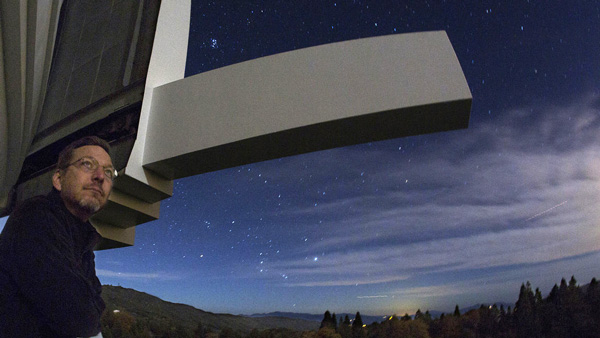
Mike Brown at Hale Telescope. (Don Bartletti. Copyright © 2014. Los Angeles Times. Reprinted with Permission)
Michael E. Brown, sometimes referred to as “the man who killed Pluto”, has an impressive record of transneptunian object (TNO) discoveries attributed to him and his research team. With Chad Trujillo and David Rabinowitz, Brown discovered the TNO Eris, notable for being more massive than Pluto, which prompted the International Astronomical Union to revise the definition of “planet.”
Brown obtained his Ph.D. in 1994 from the University of California at Berkeley with his work on the volcanism of Jupiter’s innermost large satellite, Io. He became intrigued with the small objects that lurk in the outer Solar System while he was a graduate student—Jane Lưu, who with David Jewitt discovered the first known TNO after Pluto and Charon, worked in the same department.
After two years as a Hubble Fellow, Brown joined the Caltech faculty in 1997 as an assistant professor and decided to pursue his investigation of the Kuiper Belt using the Samuel Oschin Telescope. First with photographic plates and later with CCD cameras, his program began yielding several TNOs a year between 2001 and 2008 including Quaoar (2002), Sedna (2003), Orcus (2004), and Eris and Makemake (2005).
In 2010 Brown published his book How I Killed Pluto and Why It Had It Coming, an account of the events surrounding the redefinition of the term planet that eventually changed the status of Pluto. In 2016, he and Konstantin Batygin proposed the existence of “Planet Nine,” a large object whose gravitational pull would explain the improbable orbital configuration of a group of TNOs that orbit mostly beyond the Kuiper Belt. [b10] [t09] [m16]
Alphabetical Index
References [show]
- W. Adams (1939) Biographical Memoir of George Ellery Hale, BMNAS, 21:181.
- H. Arp (June 1961) Wilhem Heinrich Walter Baade, JRASC, 55:113.
- D. Abbott (1988) Industry Mourns Entrepreneur Mark Serrurier.
- L. Aller (June 1989) Obituary - Abell, George, QJRAS, 30:283.
- M. Brown (2010) How I Killed Pluto and Why It Had It Coming, Random House.
- A. Benter (October 2012) Caltech Mourns the Passing of Wallace L. W. Sargent.
- I. Bowen (1962) John August Anderson, BMNAS, 36:1.
- H. Babcock (1982) Ira Sprague Bowen, BMNAS, 53:83.
- G. Berry (January-February 1977) Man of Parts, E&S, 40(2):29.
- M. Chapman (2001) Gene Shoemaker - Founder of Astrogeology, USGS.
- M. Chapman (May 2002) Carolyn Shoemaker, USGS.
- Corning Museum of Glass Mirror to Discovery: The 200-inch Disk and the Hale Reflecting Telescope at Palomar.
- T. Dunham (February 1939) Obituary Notices: Associates:- Hale, George Ellery, MNRAS, 99:322.
- E. Dennison (April 1967) Electronics and the New Astronomy, E&S, 30(7):9.
- E. Dennison (November 1970) Automated Astronomy, E&S, 34(2):12.
- D. DeVorkin (2011) Allan R. Sandage, BAAS, 43:39.
- B. Ellis (2004) John Beverley Oke, 1928 – 2004, E&S, 67(1):41.
- Caltech (June 1948) Shops at Caltech, E&S, 11(6):13.
- Caltech (June 1948) The Palomar Story, E&S, 11(6):18.
- R. Florence (1994) The Perfect Machine, HarperPerennial, 259–261, 352–355, 403–404, 405–406.
- J. Gunn (December 2003) Obituary: Jesse Greenstein, 1909-2002, BAAS, 35:1463.
- J. Gunn (March 2005) Obituary: John Beverly Oke (1928–2004), PASP, 117:221.
- Gruber Foundation (2005) James Gunn, Gruber Cosmology Prize.
- J. Greenstein and A. Wilson (March-April 1974) Remembering Zwicky, E&S, 37(5):15.
- K. Hentschel (2014) Anderson, John August, Biographical Encyclopedia of Astronomers.
- R. Kroon (1970) What's Past is Prologue: A Personal History of Engineering, ASME.
- L. Kuhi (March 1976) Obituaries: Rudolph L Minkowski, PT, 29(3):78.
- A. Lightman (March 1989) Interview of Maarten Schmidt, Niels Bohr Library & Archives AIP.
- A. Lightman (April 1989) Interview of Vera Rubin, Niels Bohr Library & Archives AIP.
- B. Lambert (28 March 1992) John Strong, 87, Expert in Optics And Astronomy, NYT, 1001030.
- D. Levy (1998) Comets: Creators and Destroyers, Simon and Schuster, 202–206.
- D. Martin (8 March 2004) J. Beverley Oke, Analyzer of Starlight, is Dead at 75, NYT, A17.
- B. Marsden (January 2009) Eleanor Helin (1932–2009), ICQ, 31(1):3.
- D. Martin (3 October 2014) Gerry Neugebauer, Pioneer in Space Studies, Dies at 82, NYT, A25.
- P. Morrison (14 September 2016) Patt Morrison asks: Caltech astronomers Mike Brown and Konstantin Batygin on finding a replacement for Pluto, LAT, Opinion.
- P. McCray (February 2003) Interview of Wallace Sargent, Niels Bohr Library & Archives AIP.
- P. McCray (2006) Giant Telescopes: Astronomical Ambition and the Promise of Technology, Harvard University Press.
- Anonimous (February 1939) Obituary Notices: Fellows:- Pease, Francis, MNRAS, 99:312.
- K. MacPherson (September 2009) Gunn wins National Medal of Science, Princeton University.
- Minor Planet Center Minor Planet Discoverers.
- New York Heritage Digital Collections Pouring the 200 inch disk at Corning Glass Works.
- D. Osterbrock (2001) Walter Baade, A Life in Astrophysics, Princeton University Press.
- D. Osterbrock (June 2003) Don Hendrix, Master Mount Wilson and Palomar Observatories Optician, JAHH, 6:1.
- D. Overbye (17 November 2010) Allan Sandage, Astronomer, Dies at 84; Charted Cosmos’s Age and Expansion, NYT, B19.
- D. Overbye (28 December 2016) Vera Rubin, 88, Dies; Opened Doors in Astronomy, and for Women, NYT, A18.
- D. Osterbrock (1983) Rudolph Minkowski, BMNAS, 54:271.
- J. O'Connor and E. Robertson (August 2005) Charles Max Mason.
- R. Porter (June 1948) From Russell W. Porter, E&S, 11(6):32.
- R. Preston (1987) First Light: The Search for the Edge of the Universe, The Atlantic Monthly Press, 65–128, 131–207.
- R. Prud'homme (February-March 1982) Interview of Jesse L. Greenstein, Oral History Project, Caltech.
- Anonimous (July 1976) Obituaries: George V. McCauley, PT, 29(7):71.
- B. Rule (August 1948) Engineering Aspects of the 200-inch Hale Telescope, PASP, 60:225.
- M. Schmidt (2008) Autobiography, Kavli Prize.
- M. Schmidt (September 2013) The Discovery of Quasars, Fifty Years of Quasars (symposium), Caltech.
- N. Straumann (2013) Fritz Zwicky: An Extraordinary Astrophysicist, SPS.
- K. Svitil (October 2014) Remembering Gerry Neugebauer, Caltech News.
- Stellafane Russell W. Porter's Drawings of Palomar.
- Star Men (2015) Prof. Wallace L. W. Sargent.
- S. Soter and N. Tyson (2000) Cosmic Horizons: Asrtonomy at the Cutting Edge, New Press/AMNH.
- R. Tindol (October 2002) Caltech Astronomer Jesse Greenstein Dies; Was Early Investigator of Quasars, White Dwarfs, Caltech News.
- N. Tyson (2009) The Pluto Files: The Rise and Fall of America’s Favorite Planet, W. W. Norton.
- G. Wallerstein (December 2003) Jesse Leonard Greenstein, PT, 56(12):84.
- W. Weaver (1964) Max Mason, BMNAS, 37:205.
- C. Weiner (August 1968) Interview of Ira Sprague Bowen, Niels Bohr Library & Archives AIP.
- C. Weiner (August 1969) Interview of Ira Sprague Bowen, Niels Bohr Library & Archives AIP.
- S. Weart (November 1977) Interview of George Abell, Niels Bohr Library & Archives AIP.
- Women in Technology International (1998) Eleanor Francis Helin, WITI Hall of Fame.
Questions? We've answered many common visiting, media, and academic questions in our public FAQ page.
Please share your feedback on this page at the
COO Feedback portal.
Personalities / v 1.0.5
Last updated: 14 September 2023 AFB/SBF/JEM
|
|
|
